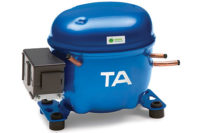
|
| Panel discussions at the first ATMOspheres America event in 2012 will be part of the second such event this June in Washington, D.C. |
The attention being paid to so-called natural refrigerants is showing a shift toward hydrocarbon refrigerants, even as CO2 gains a stronger foothold and ammonia maintains a high profile. But, whether or not there will be a dominant natural choice remains unclear even in Europe, much less North America.
Picking a Winner
There has been some jockeying of positions. Ammonia is being tried more and more in smaller applications. CO2 first hit North American shores a decade ago and has grown in applications including transcritical. Now hydrocarbons (HCs) are gaining more attention.
European marketing organization Shecco is in the process of surveying those involved in refrigerants and refrigeration regarding natural refrigerant market trends. This survey will include responses from more than 50 European countries. The organization noted that a special focus will be put on the business case for natural refrigerants as well as the training and policy dimension.
This effort is significant because it will extend the conversation on natural refrigerants well beyond the scope of environmentalists and the green movement in Europe. The survey will examine the return on investment in using such refrigerants, necessary technician training, and how regulations will affect decisions.
It was noted, “The survey is specifically addressed to industry experts and end users interested in natural refrigerants (NR). This includes all those that are using or providing NR solutions, but also those not (yet) active in NR solutions. The survey inquires about the current and future use of carbon dioxide, ammonia, HCs, water, and air as refrigerants in mobile and stationary applications. It will collect input to evaluate the economic importance of NR in today’s HVACR industry and among commercial/industrial end-users, as well as shed light on market projections until 2020.”
Water Cooler Conversation
Discussions related to natural refrigerants are growing globally. The organization ATMOspheres is planning six conferences on the topic including one for Washington, D.C., ATMOspheres America, June 18-19 at the Liaison Capital Hill Hotel. The event is subtitled, “The Business Case for Natural Refrigerants,” and is the second such event held in the U.S., the first occurred in 2012. The sponsoring organization said the conference will “showcase the latest technologies, trends, and regulatory issues. The event serves as a meeting place for industry experts.”
Similar events in 2013 have been planned for Vienna; Bangkok; Tokyo; Brussels; and Kiev, Ukraine.
The Ukraine event, scheduled for late October, is taking place during the United Nations Environment Program 24th Meeting of the Parties to the Montreal Protocol (MOP24). Within the context of such events are panel discussions concerning ozone and climate issues factored into technologically viable, efficient, and safe alternatives to HCFCs. Ongoing discussions involve European Union f-gas regulation, as well as information on natural refrigerant technology trends in Europe and developing countries.
Emphasis on HCs
Rick Reddington, executive vice president, Techno Tools Corp., recently recognized this increased HC attention through communications with The NEWS. He shared, “The use of HC refrigerants is a new matter in the U.S. stationary HVAC market.
“However, Europe and Asia have been using HCs for over 10 years. Earlier this year, the U.S. EPA [Environmental Protection Agency] added hydrocarbons R-290 (propane), and R-600a (isobutene), plus a new patented blend R-441A to their SNAP [Significant New Alternatives Policy] list for approved commercial and residential refrigeration applications. Article 6, paragraph 3 of the EU Directive 2006/40/EC, was created to discourage the use of systems designed to contain fluorinated greenhouse gases (f-gases) with a global warming potential (GWP) higher than 150. Propane and isobutene have a GWP of zero.”
He continued, “The EPA acted after receiving comments from the General Electric Co., the Coca-Cola Co., Ben & Jerry’s Homemade Inc., True Manufacturing, and many others.”
Reddington noted, “As a result of the EPA’s action in the U.S., we have renamed our combustible gas detector model D540 to be the ‘HC Refrigerant Gas and Combustible Gas Leak Detector.’ We predict that there will become a time when wholesalers and distributors in the U.S. will be stocking components and tools specifically designed to service equipment charged with HC refrigerants.”
Refrigeration Compressors
It was noted that Tecumseh Products Co. had launched a range of compressors and condensing units designed for use with HC refrigerants. There are also reported evolutions in the design of some new central a/c systems in the U.S. to switch to HCs.
In addition to the Tecumseh developments, another significant announcement regarding HC refrigerants was made by Embraco, who used the AHR Expo in Dallas to say that it had a “full range of hydrocarbon compressors available for North America including low-temp cooling capacities from 520 Btuh up to 4,780 Btuh and high temp from 4,700 Btuh up to 10,125 Btuh.”
The company said that according to the United Nations Environment Program 2010, hydrocarbon usage is projected to more than double from 2012 to 2020.
“We’re proud to offer a full range of hydrocarbon compressors to the U.S. market that are UL recognized, have nearly no GWP or ODP, and are more energy-efficient than current HFCs. In the end, we believe that it’s about providing innovative solutions which exceed our customers’ needs and minimize the total environmental impact. Embraco has the products to do that,” said Doug Schmidt, commercial cooling solutions manager for North America.
Publication date: 6/3/2013
Want more HVAC industry news and information? Join The NEWS on Facebook, Twitter, and LinkedIn today!







